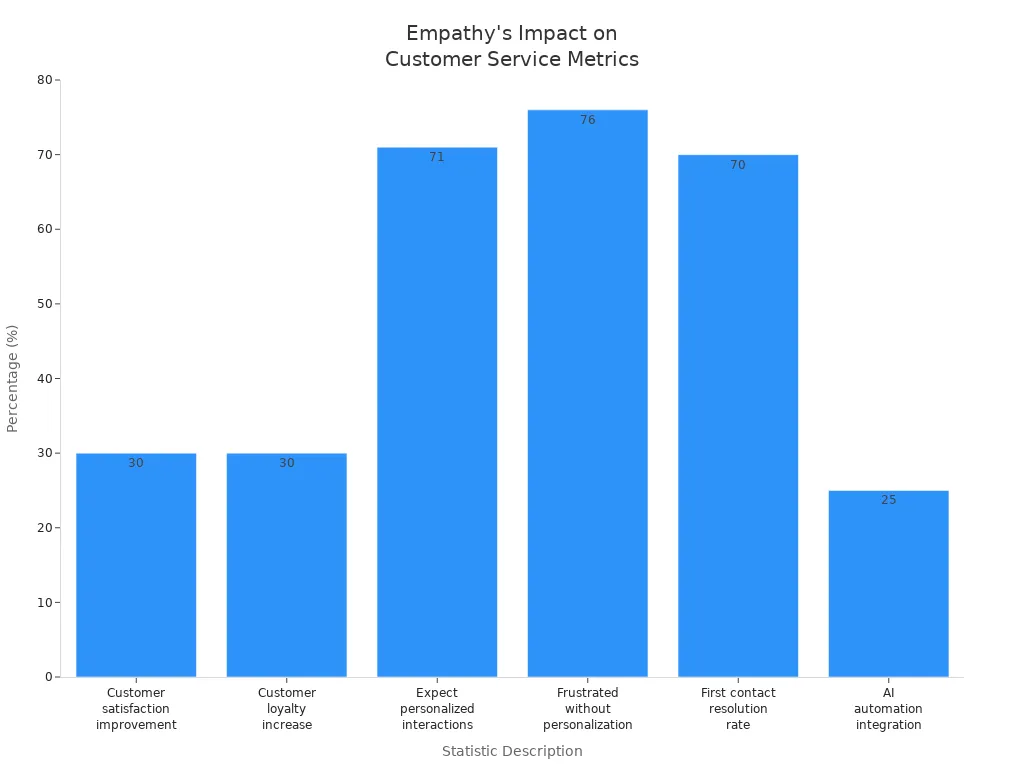Why Empathy Is Important in Customer Service Teams Today

Empathy in customer service shapes every customer experience. When you show empathy, you help customers feel heard and valued. Studies reveal that 71% of consumers expect personalized interactions, and 76% feel frustrated without them. Sobot AI and Sobot call center solutions let you understand customer needs and respond with care. Companies using empathy in customer service see up to a 30% rise in satisfaction and loyalty.
| Statistic Description | Value/Impact |
|---|---|
| Improvement in customer satisfaction with AI emotional recognition | Up to 30% increase |
| Increase in customer loyalty for companies using emotion-driven strategies | 30% increase |
| Consumers expecting personalized interactions | 71% |
| Consumers frustrated when personalized interactions are absent | 76% |

Think about a time you felt truly understood by a support agent. That is why empathy is important in customer service.
Why Empathy Is Important in Customer Service

Customer Expectations Today
You live in a world where customer expectations change quickly. Five years ago, many people felt happy just getting a fast answer. Now, you want more than speed. You want to feel understood and respected. This shift explains why empathy is important in customer service today.
- Customers expect a mix of smart technology and real human care. You want AI to handle simple questions, but you also want a real person to help when things get tough.
- Empathy in customer service builds trust. When you face a problem, you want someone who listens and cares about your feelings.
- You expect every company to treat you as an individual. You want to feel seen, heard, and valued in every interaction.
- Companies must train their teams to show empathy, solve problems, and communicate well. This training helps meet your growing needs.
- The best brands balance AI and human empathy. AI can help with quick answers, but only people can truly connect with you.
Sobot understands these changes. As a leader in customer-centric contact center solutions, Sobot uses advanced AI to support agents. Sobot’s technology recognizes emotions and helps agents respond with care. This approach makes every customer experience feel personal and meaningful.
Note: Empathy is not just a nice-to-have. It is now a basic expectation. You want companies to care about your feelings, not just your questions.
Impact on Satisfaction and Loyalty
Empathy in customer service does more than make you feel good. It shapes your loyalty and satisfaction. When you feel respected and understood, you are more likely to stay with a brand. This is why empathy is important in customer service for every business.
- 81% of customers like you will buy again after a positive, empathetic service experience.
- 95% of proactive service efforts, which include empathy, improve customer retention.
- 61% of people switch to another company after poor service, often because they did not feel understood.
- 71% of customers leave after just one bad experience, showing how costly a lack of empathy can be.
- Companies that focus on empathy in customer service see higher retention rates and better performance.
Empathy also drives key business metrics. For example, Net Promoter Score (NPS) measures how likely you are to recommend a brand. Brands like Amazon and Warby Parker use NPS to track loyalty. When you feel your feedback matters, you stay loyal. A 10-point rise in NPS can mean a 10-20% increase in revenue. Acting on feedback can boost retention by 14%. These numbers show why empathy is important in customer service and how it leads to real business growth.
Sobot’s solutions help companies deliver empathy at scale. With features like emotion recognition and a unified workspace, Sobot lets agents see your history and needs in one place. This means you get faster, more personal help. Sobot’s AI supports agents, but never replaces the human touch. This balance leads to higher satisfaction and loyalty.
Michael Kors: A Real-World Example
Michael Kors, a global fashion brand, wanted to improve its customer experience. The company used Sobot’s all-in-one platform to connect all its service channels. Agents could see your order history, chat with you on WhatsApp, and solve problems faster. After using Sobot, Michael Kors cut response times by 83%. Customer satisfaction jumped to 95%. Conversion rates rose by 20%. These results show why empathy is important in customer service. When you feel understood, you trust the brand and come back again.
Tip: When you choose a company that values empathy in customer service, you get better support and feel more loyal.
Sobot’s approach matches industry best practices. The platform uses AI to detect emotions and help agents respond with care. In retail, Sobot’s chatbots suggest products based on your mood. In gaming, the system supports players who feel frustrated. In healthcare, chatbots notice when you feel upset and offer gentle support. Sobot also protects your data and follows strict ethical rules. This builds trust and keeps your information safe.
Empathy in customer service is not just about being nice. It is about understanding your needs, solving your problems, and making you feel valued. Sobot’s tools help companies do this every day. When you get empathetic service, you are more likely to stay, buy again, and tell your friends. That is why empathy is important in customer service for every business that wants to grow.
Empathy in Customer Service Defined
What Is Empathy?
You might wonder what empathy in customer service really means. Empathy is more than just being polite or saying “I’m sorry.” It is about understanding how a customer feels and showing that you care. Psychological research explains that empathy has two main parts: cognitive empathy and emotional empathy. Cognitive empathy helps you understand what someone else is thinking or feeling. Emotional empathy lets you feel what another person is experiencing emotionally. When you use empathy in customer service, you recognize the customer’s emotions and respond in a way that builds trust.
Empathy in customer service motivates you to take caring actions. For example, when a customer feels upset about a delayed order, you do not just fix the problem. You also let them know you understand their frustration. This approach creates a positive feedback loop. Customers feel valued, which releases oxytocin, the “trust” hormone. This reduces stress and makes customers more willing to cooperate. Research shows that customer satisfaction scores are 35% higher when customers sense genuine empathy.
Sobot’s unified workspace helps you practice empathy in customer service. You see the customer’s history and needs in one place, so you can respond quickly and personally. This makes every interaction smoother and more meaningful.
Tip: Empathy in customer service is not about agreeing with every complaint. It is about showing you care and want to help.
Empathy vs. Sympathy
You may hear people use empathy and sympathy as if they mean the same thing. They do not. Sympathy means you feel sorry for someone, but you do not always understand why they feel that way. For example, you might say, “I’m also unhappy with how that product works.” This response can make you feel emotionally drained.
Empathy in customer service is different. You acknowledge the customer’s feelings and show understanding without becoming overwhelmed. You might say, “I can understand why that makes you angry.” This keeps you professional and caring at the same time. Empathy helps you solve problems while making the customer feel heard.
- Sympathy can lead to emotional exhaustion.
- Empathy helps you stay calm and effective.
- Empathy in customer service goes beyond saying “I’m sorry.” It shows you truly understand and want to help.
Sobot encourages you to use empathy in customer service, so you can build trust and resolve issues faster.
Benefits of Empathy for Teams and Businesses
Customer Satisfaction Gains
Empathy in customer service helps you build strong relationships with your customers. When you listen and understand their feelings, you make them feel valued. This leads to higher satisfaction and loyalty. Teams that focus on empathy in customer service see real improvements:
- You get better customer feedback and higher satisfaction scores.
- Resolution times drop because agents understand problems faster.
- Sentiment analysis shows more positive emotions in customer interactions.
- Companies like Amazon and Apple have high satisfaction scores because they use empathy in customer service every day.
- Empathy-driven teams often see higher Net Promoter Scores (NPS) and better customer retention.
When you use empathy in customer service, you create a cycle where happy customers come back and share good reviews. This helps your business grow.
Business Outcomes
Empathy in customer service does more than make customers happy. It also helps your business succeed. When you show empathy, you increase customer lifetime value and repeat business. Studies show that 73% of people say customer experience affects their buying decisions (PWC). Companies that lead in customer experience can earn up to 80% more revenue.
Empathy in customer service also helps your team. Training your agents to use empathy reduces stress and turnover. It creates a positive work culture and helps everyone work together. When your team feels good, they help customers better. This leads to more sales, stronger relationships, and long-term growth.
Sobot Voice/Call Center Value

Sobot’s Voice/Call Center and omnichannel solutions help you deliver empathy in customer service at scale. With Sobot, your agents see all customer information in one place. This means they can respond quickly and personally. Sobot’s AI-powered tools help agents understand customer emotions and needs. For example, Michael Kors used Sobot to cut response times by 83% and reach a 95% satisfaction rate.
Sobot’s omnichannel platform lets you connect with customers on phone, chat, email, and social media. You never have to ask customers to repeat themselves. This unified approach makes every interaction feel personal and caring. Companies using Sobot report higher satisfaction, better first-call resolution, and more loyal customers. Empathy in customer service becomes easy when you have the right tools and support.
Risks of Lacking Empathy in Customer Service

Negative Customer Experiences
When you do not use empathy in customer service, customers notice right away. They feel ignored and undervalued. Many people say they do not get a real apology or see anyone take responsibility for mistakes. This leads to frustration and lost trust. Here are some common problems you might see:
- Customers feel there is no genuine apology or admission of responsibility.
- Customers experience frustration due to lack of emotional engagement.
- Customers feel undervalued and unheard.
- This leads to lost customers and decreased trust in the service.
- Lack of empathy results in disillusionment with the overall service.
Research shows that negative customer experiences often include long wait times, inconsistent answers, and no follow-up. These issues make customers feel stuck and unsupported. When you do not show empathy in customer service, you risk losing customers and getting negative reviews. This can hurt your brand and make it hard to attract new customers.
| Negative Customer Experience Type | Description | Impact on Customer Experience |
|---|---|---|
| Lack of Sympathy | Dismissive or indifferent responses to customer problems | Customers feel unimportant and frustrated, leading to dissatisfaction and potential loss of business |
| Long Wait Times | Delays in response or resolution when customers seek help | Customers feel stuck and frustrated, often resulting in switching to competitors |
| Inconsistent Communication and Messaging | Conflicting information from different support channels or representatives | Erodes customer confidence and trust, causing confusion and mistrust |
| Lack of Follow-up or Resolution | Failure to provide solutions or follow up on customer issues | Customers feel abandoned and unsupported, increasing frustration and dissatisfaction |
Team Morale and Performance
Empathy in customer service does not just help customers. It also supports your team. When you do not use empathy, your team feels excluded and disconnected. This lowers morale and increases turnover. Employees who do not feel valued may stop trying their best or even leave the company. High turnover puts stress on everyone and makes it hard to build strong teams.
- High employee turnover increases stress on remaining team members due to constant onboarding and ramp-up of new hires.
- Frequent changes in leadership prevent employees from building trust and connection with managers, lowering morale.
- Lack of clear communication and transparency from leadership during times of high turnover causes employees to lose faith and feel disconnected.
- Stressful company culture driven by instability and turnover reduces employees’ ability to focus and perform effectively.
Empathy-focused training can help. When you encourage your team to share positive experiences and listen to each other, you build trust and improve job satisfaction. Sobot’s unified workspace helps teams work together and support each other, making empathy in customer service easier to practice every day.
Business Impact
Ignoring empathy in customer service can damage your business in many ways. Customers who feel ignored often leave negative reviews on sites like Trustpilot or the Better Business Bureau. This public feedback can hurt your reputation and drive away new customers. You may also lose loyal customers, which lowers your revenue.
Imagine a customer waiting 30 minutes to be met with disinterest and blame from a representative, who refuses to escalate the issue and dismisses the customer's concerns. Follow-up attempts via hotline and email are met with long holds and generic responses. This experience shows lack of empathy and accountability, leading to customer frustration, dissatisfaction, and loss of trust.
Empathy-driven companies see better results. They build trust, loyalty, and long-term relationships. Research shows that companies with strong empathy in customer service achieve up to 2.5 times greater revenue growth than those that do not (source). Sobot’s solutions help you deliver empathy in customer service, protect your brand, and grow your business.
Empathy Training and Strategies
Active Listening
Active listening stands at the heart of empathy training. When you practice active listening, you focus on the speaker, avoid distractions, and show that you care about their feelings. This skill helps you build trust with customers and your team. Training experts recommend several techniques to improve empathy in customer service through active listening. You can see these techniques and their benefits in the table below:
| Technique/Aspect | Description |
|---|---|
| Building Trust | Active listening shows respect for others’ thoughts and feelings. This builds trust and rapport. |
| Improving Problem Solving | Listening deeply helps you understand problems and find better solutions. |
| Enhancing Leadership | Leaders who listen well make better decisions and support their teams. |
| Increasing Productivity | Teams that listen to each other work better and feel more satisfied. |
| Reflective Questions | - How well do you respond to others’ feelings and needs? - Do you seek feedback on your listening? - Are you fully present during conversations? - What behaviors do good listeners show that you can model? |
You can use these reflective questions to check your own customer service skills. When you listen actively, you help customers feel heard and valued. This approach also helps your team solve problems faster and work together more smoothly.
Sobot’s unified workspace supports active listening by giving you all the customer’s information in one place. You can see past interactions, preferences, and feedback. This makes it easier to respond with care and attention. Sobot’s analytics also help you track how well your team uses active listening in real time.
Tip: Try to repeat back what the customer says in your own words. This shows you understand and helps avoid misunderstandings.
Personalization
Personalization makes every customer feel special. When you use a customer’s name or mention details from their history, you show that you see them as a person, not just a case. Personalization is a key part of empathy training and helps improve empathy in customer service.
- Personalization helps customers feel recognized and valued.
- Adjusting your language to match the customer’s mood shows you care about their feelings.
- Personalized responses reduce frustration and build trust.
- Training in personalization and emotional intelligence strengthens your empathy skills.
- Customers say that emotional engagement from personalization drives loyalty and a positive brand reputation.
- Moving away from scripted replies and using real, personal messages keeps empathy strong in customer service.
You can use Sobot’s omnichannel solution to personalize every interaction. The platform brings together chat, phone, email, and social media. You see all the customer’s data in one place, so you can tailor your responses. This approach helps you deliver a consistent and caring experience across every channel.
Note: Personalization is not just about using a name. It means understanding the customer’s needs and feelings in every conversation.
Empathy Training Methods
Empathy training gives you the tools to connect with customers and your team. Many methods help you build empathy skills. Training experts suggest using a mix of activities for the best results. Here is a table of common empathy training methods and how you can use them:
| Training Method | Description | Example Application in Training Context |
|---|---|---|
| Role play | Practice real-life situations with teammates. | Simulate tough customer calls or chats. |
| Discussion | Share ideas and experiences in a group. | Talk about empathy challenges and solutions. |
| Feedback | Get input from others about your communication style. | Ask for feedback on how empathetic you sound. |
| Lecture | Learn from trainers about empathy theory and best practices. | Listen to a presentation on empathy in customer service. |
| Individual topic elaboration | Reflect on your own experiences and feelings. | Write about a time you helped a customer feel heard. |
| Team topic elaboration | Work together to improve a failed customer interaction. | Rewrite a poor chat transcript as a team. |
| Conversation with experts | Ask questions and learn from empathy specialists. | Join a Q&A with a customer service leader. |
| Observation of exemplary interactions | Watch videos or read transcripts of great customer service. | Study how top agents handle tough situations. |
Studies show that empathy training works best when you combine different methods. For example, you can start with a lecture, then do role play, and finish with group feedback. This approach helps you practice new skills and see them in action.
You can also use empathy exercises like sharing customer stories or practicing reflective listening. These activities help you step into the customer’s shoes and see things from their point of view. Sobot’s analytics let you measure the impact of empathy training by tracking customer satisfaction, Net Promoter Score (NPS), and first call resolution rates. You can use these insights to coach your team and keep improving.
Try this empathy exercise: Pair up with a teammate and take turns sharing a recent customer interaction. Listen without interrupting, then repeat back what you heard. This builds trust and sharpens your active listening.
Leadership and Culture
Leaders play a big role in building a culture of empathy. When leaders listen, understand, and act with care, they set the tone for the whole team. Empathetic leadership helps you feel valued and supported at work. This approach boosts engagement, retention, and innovation.
- Empathetic leaders listen actively and take purposeful action.
- Leadership empathy improves team engagement and reduces turnover.
- A culture of empathy creates safe spaces for open dialogue and feedback.
- Empathetic workplaces support well-being with flexible hours, mental health support, and family leave.
- Leaders who model empathy help teams feel safe to share ideas and concerns.
- Empathy skills grow stronger when leaders encourage open communication.
You can help build a culture of empathy by sharing success stories, celebrating team wins, and supporting each other. Sobot’s unified workspace and analytics make it easy to spot and reward empathetic behaviors. You can use real-time data to coach your team and keep empathy at the center of your customer service skills.
Callout: Empathy is not just a skill. It is a value that shapes your team’s culture and success.
Overcoming Common Challenges
Customer service teams face many challenges when they try to improve empathy in customer service. Handling complaints, managing angry customers, and dealing with high workloads can make it hard to stay empathetic. Here is a table of common challenges and ways to overcome them:
| Challenge | Description | Solutions |
|---|---|---|
| Handling Complaints and Negative Feedback | Poor complaint handling can turn loyal customers away. | Train staff in active listening and empathy; use clear complaint systems; collect customer feedback. |
| Employee Burnout and Churn | High turnover hurts service quality and raises costs. | Offer good pay, listen to staff, create a supportive culture, and use retention strategies. |
| Handling Angry Customers | Emotional customers can damage your brand if not handled well. | Train in conflict resolution, use the H.E.A.R.D. technique, and offer real solutions and updates. |
| Handling Multiple Customers | Too many inquiries can overwhelm agents and slow responses. | Use AI chatbots for simple questions, invest in omnichannel tools, and balance workloads. |
Sobot’s AI-powered chatbots and omnichannel solutions help you manage high volumes without losing the human touch. You can automate simple tasks and free up agents to focus on complex, emotional issues. This approach helps you maintain a culture of empathy, even during busy times.
Measuring Success
You need to measure the impact of empathy training to see real progress. You can use customer satisfaction surveys, NPS, and first call resolution rates to track how well your team connects with customers. Sobot’s analytics give you real-time feedback and trend analysis. You can spot coaching opportunities and celebrate improvements.
- Use CSAT to see how customers feel after each interaction.
- Track NPS to measure loyalty and emotional connection.
- Monitor FCR to check if customers feel fully understood.
- Analyze sentiment trends with AI-powered tools.
- Collect post-interaction feedback about feeling heard and valued.
Regular team meetings and sharing success stories help keep empathy skills strong. Continuous coaching and feedback ensure that empathy stays at the heart of your customer service skills.
Remember: Empathy training is not a one-time event. You need to practice, measure, and improve empathy in customer service every day.
Empathy in customer service shapes loyalty, drives growth, and turns customers into advocates. You build trust by listening, personalizing, and resolving issues with care. Research shows empathy leads to higher satisfaction, stronger relationships, and fewer negative reviews. Sobot’s AI-powered tools help you balance automation with a human touch, making every interaction efficient and personal.
- Empathy in customer service creates lasting loyalty and brand differentiation.
- Training in active listening and emotional intelligence boosts team performance.
- Sobot empowers you to deliver fast, empathetic support across every channel.
Make empathy your team’s superpower. Start today—lead with care, use smart tools, and watch your customer service thrive.
FAQ
What does empathy in customer service mean?
Empathy in customer service means you understand and care about how customers feel. You listen to their problems and respond with kindness. Sobot’s unified workspace helps you see customer history, so you can show empathy in customer service every time.
How does empathy in customer service improve business results?
Empathy in customer service builds trust and loyalty. According to PwC, 73% of people say customer experience affects buying decisions. Sobot’s solutions help you deliver empathy in customer service, leading to higher satisfaction and more repeat customers.
Can technology help teams show empathy in customer service?
Yes! Sobot’s AI-powered tools help you recognize customer emotions and respond quickly. For example, Sobot’s omnichannel solution lets you see all customer messages in one place. This makes it easier to practice empathy in customer service, even during busy times.
Why do teams need empathy training for customer service?
Empathy training helps you handle tough situations and upset customers. Teams with empathy in customer service solve problems faster and get better feedback. Sobot’s analytics let you track progress and coach your team to improve empathy in customer service every day.
Tip: Practice empathy in customer service by listening, personalizing your responses, and using Sobot’s tools to support your team.
See Also
How AI Agents Are Transforming Customer Support Services
Ways AI Software Enhances Customer Service Efficiency Today
Top Ten Strategies To Improve Live Chat Satisfaction
